
Sculpture is the branch of the visual arts that operates in three dimensions. Sculpture is the three-dimensional art work which is physically presented in the dimensions of height, width and depth. It is one of the plastic arts. Durable sculptural processes originally used carving and modelling, in stone, metal, ceramics, wood and other materials but, since Modernism, there has been almost complete freedom of materials and process. A wide variety of materials may be worked by removal such as carving, assembled by welding or modelling, or moulded or cast.

The Mausoleum at Halicarnassus or Tomb of Mausolus was a tomb built between 353 and 350 BC in Halicarnassus for Mausolus, an Anatolian from Caria and a satrap in the Achaemenid Persian Empire, and his sister-wife Artemisia II of Caria. The structure was designed by the Greek architects Satyros and Pythius of Priene. Its elevated tomb structure is derived from the tombs of neighbouring Lycia, a territory Mausolus had invaded and annexed c. 360 BC, such as the Nereid Monument.
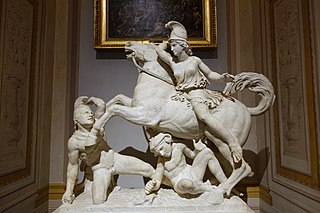
In Greek mythology, an Amazonomachy is a mythological battle between the ancient Greeks and the Amazons, a nation of all-female warriors. The subject of Amazonomachies was popular in ancient Greek art and Roman art.
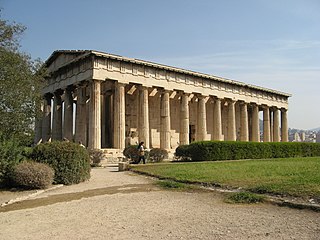
The Temple of Hephaestus or Hephaisteion, is a well-preserved Greek temple dedicated to Hephaestus; it remains standing largely intact today. It is a Doric peripteral temple, and is located at the north-west side of the Agora of Athens, on top of the Agoraios Kolonos hill. From the 7th century until 1834, it served as the Greek Orthodox church of Saint George Akamates. The building's condition has been maintained due to its history of varied use.

The sculpture of ancient Greece is the main surviving type of fine ancient Greek art as, with the exception of painted ancient Greek pottery, almost no ancient Greek painting survives. Modern scholarship identifies three major stages in monumental sculpture in bronze and stone: the Archaic, Classical (480–323) and Hellenistic. At all periods there were great numbers of Greek terracotta figurines and small sculptures in metal and other materials.

The study of Roman sculpture is complicated by its relation to Greek sculpture. Many examples of even the most famous Greek sculptures, such as the Apollo Belvedere and Barberini Faun, are known only from Roman Imperial or Hellenistic "copies". At one time, this imitation was taken by art historians as indicating a narrowness of the Roman artistic imagination, but, in the late 20th century, Roman art began to be reevaluated on its own terms: some impressions of the nature of Greek sculpture may in fact be based on Roman artistry.

Hierapolis was a Hellenistic Greek city built on the site of a Phrygian cult center of the Anatolian mother goddess Cybele, in Phrygia in southwestern Anatolia. It was famous for its hot springs, its high quality wool fabrics and dyes, and as the birthplace of the Stoic philosopher Epictetus. Its extensive remains are adjacent to modern Pamukkale in Turkey.

Delphi Archaeological museum is one of the principal museums of Greece and one of the most visited. It is operated by the Greek Ministry of Culture. Founded in 1903, it has been rearranged several times and houses the discoveries made at the Panhellenic sanctuary of Delphi, which date from the Late Helladic (Mycenean) period to the early Byzantine era.
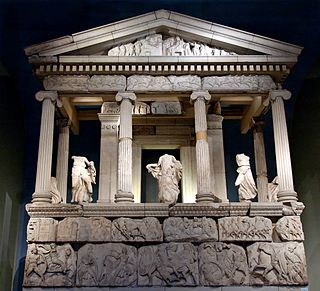
The Nereid Monument is a sculptured tomb from Xanthos in Lycia, close to present-day Fethiye in Mugla Province, Turkey. It took the form of a Greek temple on top of a base decorated with sculpted friezes, and is thought to have been built in the early fourth century BC as a tomb for Arbinas, the Xanthian dynast who ruled western Lycia under the Achaemenid Empire.

The Harpy Tomb is a marble chamber from a pillar tomb that stands in the abandoned city of Xanthos, capital of ancient Lycia, a region of southwestern Anatolia in what is now Turkey. Built in the Persian Achaemenid Empire, and dating to approximately 480–470 BC, the chamber topped a tall pillar and was decorated with marble panels carved in bas-relief. The tomb was built for an Iranian prince or governor of Xanthus, perhaps Kybernis.
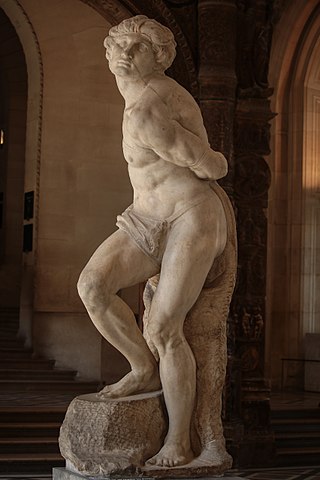
The Rebellious Slave is a 2.15m high marble statue by Michelangelo, dated to 1513. It is now held in the Louvre in Paris.

The Grave Stele of Hegeso, most likely sculpted by Callimachus, is renowned as one of the finest Attic grave stelae surviving today. Dated from c. 410 – c. 400 BCE, it is made entirely of Pentelic marble. It stands 1.49m high and 0.92m wide, in the form of a naiskos, with pilasters and a pediment featuring palmette acroteria. The relief, currently on display at the National Archaeological Museum in Athens was found in 1870 in the Kerameikos in Athens, which now houses a replica of it.

Ancient Greek art stands out among that of other ancient cultures for its development of naturalistic but idealized depictions of the human body, in which largely nude male figures were generally the focus of innovation. The rate of stylistic development between about 750 and 300 BC was remarkable by ancient standards, and in surviving works is best seen in sculpture. There were important innovations in painting, which have to be essentially reconstructed due to the lack of original survivals of quality, other than the distinct field of painted pottery.
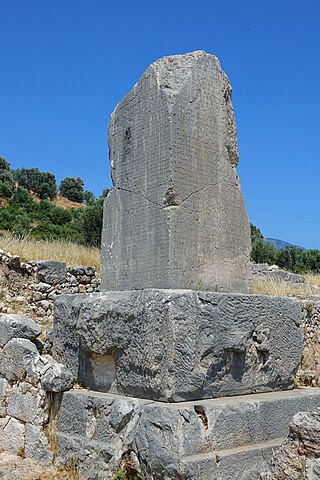
The theme of death within ancient Greek art has continued from the Early Bronze Age all the way through to the Hellenistic period. The Greeks used architecture, pottery, and funerary objects as different mediums through which to portray death. These depictions include mythical deaths, deaths of historical figures, and commemorations of those who died in war. This page includes various examples of the different types of mediums in which death is presented in Greek art.

The Apobates Base is a marble statue base featuring the scene of an Apobates competition or chariot race. The base, which is part of the collection at the Acropolis Museum in Athens, stands at 42 centimetres (17 in) in height and 86 centimetres (34 in) in width. A charioteer, armed athlete or warrior, and four horse-drawn chariot are depicted in profile relief. Named for the Greek “Apobatai” – literally the “Dismounters” – the base's relief depicts the racing event or Apobates race, which was a ceremonial part of the Panathenaic Games. In this event athletes would race against other athletes by dismounting and remounting moving chariots for prizes and renown.

The Grave Stele of Dexileos is the stele of the tomb of an Athenian cavalryman named Dexileos who died in the Corinthian War against Sparta in 394 BC. The stele is attributed to "The Dexileos Sculptor". Its creation can be dated to 394 BC, based on the inscription on its bottom, which provides the dates of birth and death of Dexileos. The stele is made out of an expensive variety of Pentelic marble and is 1.86 metres tall. It includes a high relief sculpture depicting a battle scene with an inscription below it. The stele was discovered in 1863 in the family plot of Dexileos at the Dipylon cemetery in the Kerameikos cemetery of Athens. It was found in situ, but moved during World War II, and is now on display in the Kerameikos Museum in Athens.

Xanthos, also called Xanthus, was a chief city state of the Lycians, an indigenous people of southwestern Anatolia. Many of the tombs at Xanthos are pillar tombs, formed of a stone burial chamber on top of a large stone pillar. The body would be placed in the top of the stone structure, elevating it above the landscape. The tombs are for men who ruled in a Lycian dynasty from the mid-6th century to the mid-4th century BCE and help to show the continuity of their power in the region. Not only do the tombs serve as a form of monumentalization to preserve the memory of the rulers, but they also reveal the adoption of Greek style of decoration.

The Kerameikos steles are a collection of sculptures used as grave-markers in the Kerameikos necropolis of Attica. Kerameikos is located outside the Themistoclean Wall's Dipylon Gate. Stelai come in various shapes/designs and depict images varying from pottery to narrative scenes. They were often marble or limestone, and were carved or sculpted to depict the person being memorialized sometimes with relatives or slaves. Reliefs decorating the graves were meant to show the dead in their best light, using imagery to recognize their bravery in battle, or pathos, or wealth. These monuments marked the graves of Athenian men, fallen warriors, as well as non-citizens. Women were also included in Kerameikos but typically it was the wealthiest or prominent women who were given stele. In many vase paintings of grave scenes wreaths are seen resting at the base of stele. This was likely a popular way to adorn the graves of loved ones.

The Tomb of the Haterii is an Ancient Roman funerary monument, constructed between c. 100 and c. 120 CE along the Via Labicana to the south-east of Rome. It was discovered in 1848 and is particularly noted for the numerous artworks, particularly reliefs, found within.

The Funerary naiskos of Demetria and Pamphile is a tomb memorial in honour of two deceased women named Demetria and Pamphile, erected in Athens in around 320 BC, shortly after Pamphile's death. It is made of marble and now kept at the Kerameikos Archaeological Museum in Athens, Greece, with inventory number P687, while a copy of it is found on the ancient site of the tomb.






















